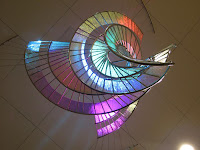Photo Link: http://www.squidoo.com/funkychairs
Ergonomic is the science of equipment design that is intended to provide comfort to users. There are five steps in ergonomic research, of which are safety, comfort, ease of use, performance, and aesthetics. Through ergonomic designs, designers interact with users by thinking about their needs, which gives them ideas on how to improve equipments to maximize their productivity.
The first step of the research is safety, and this would be the step considered first. Safe equipments are something consumers would look to buy. The white orchid chair in the image above, for example, fulfills the step of safety as the chair is proportionally balanced to not allow the chair to tip over. It has stable leg holders at the back, of which are connected, while the two in the front are separate.
The second step of the research is comfort. In looking at the above chair, it exhibits a form of comfort with its lowness, giving people a time where they can “lie low” and relax. I’ve never sat on one, but from its image, I do notice that the back rest of the chair is curved inside to allow ones back to lean on, while the head can lie itself on the chair as the top back of the chair is curved back. The seat is also not the typical flat seat we see on most chairs but is also curved like an arch, where the legs can rest as well.
The third step would be ease of use, and this chair portrays this with its low height so that anyone can use it. There is no difficulty in using this chair because one just has to lie down and relax. Other than its low height, the weight of the chair may also be lighter because it’s not as big/tall as other chairs.
The fourth step would be performance, or productivity. How well does the equipment work? Does the chair tip over to one side because it’s imbalanced? Designers consider the performance of their equipments as well because they want people to use it without a hard time.
Many designs in society have successfully completed the first four steps, as designers work their way into the level of aesthetics, the philosophy of beautiful. Some designs may exhibit this, while others may have focused on just the first four steps. But in the white orchid chair, its designer shows aesthetics in the design by modeling the chair after an orchid flower. It’s not the typical flat, four legged chair that we may see everywhere. The chair is also white, which may express a form of calmness, as one would find while relaxing on the chair itself.
Designers often think about their users when they design something because this is their purpose in creating equipments. It won’t be a good design if it’s not appreciated by their users, so designers work very hard to achieve their goals. The most basic step to consider is safety, and after they’ve accomplished this step, they can then move on to considering the other aspects of ergonomic designing. Ergonomic design is pretty successful in our design society today because designers are creating objects that are both safe and beautiful so that it will appeal to the people.







